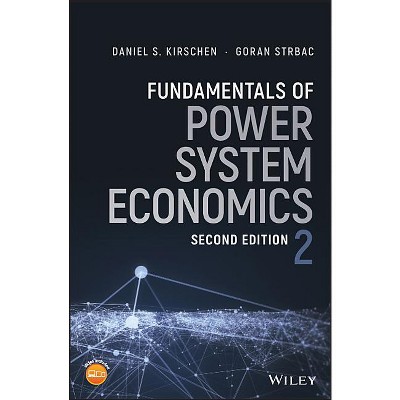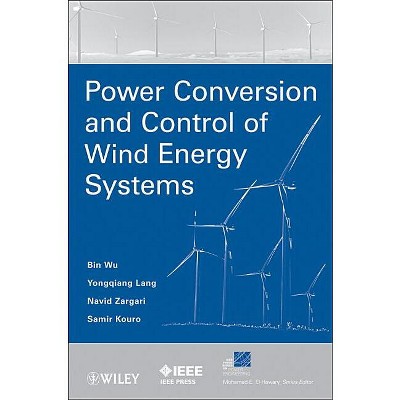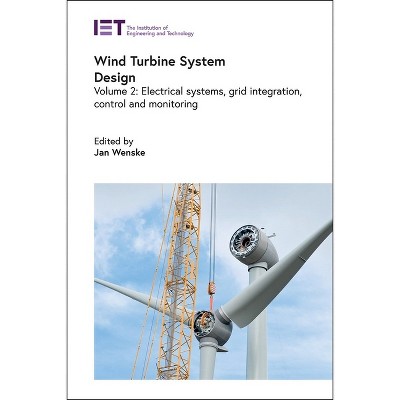Sponsored

Power Systems - by Daniel S Kirschen (Hardcover)
In Stock
Sponsored
About this item
Highlights
- Fresh perspective on power systems, dealing with uncertainty, power electronics, and electricity markets Power Systems is a highly accessible textbook on a subject that helps students understand how power systems work and the fundamental constraints that guide its operation and design.
- About the Author: Daniel S. Kirschen is the Donald W. and Ruth Mary Close Professor of Electrical and Computer Engineering at the University of Washington, USA.
- 336 Pages
- Technology, Power Resources
Description
About the Book
"Electricity provides a clean, efficient, versatile, and economical way to deliver energy. Efficient generators have been designed to convert other forms of energy into electrical energy. Transmission lines carry large amounts of energy over long distances. Electric motors are efficient and make possible precise motion control. Electricity is also the only way to power electronic devices. However, there is one drawback to using electricity as an energy vector: storing significant amounts of energy in electrical form is not practical. Delivering significant amounts of electrical energy must therefore take place as a continuous process. The rate at which electrical energy flows (i.e., power) is the fundamental concept. Generating electric power from primary energy sources, transmitting it over long distances and converting it into another form of power for a variety of end uses on an uninterrupted basis requires a set of devices working in a coordinated fashion. This is what we call a power system"--Book Synopsis
Fresh perspective on power systems, dealing with uncertainty, power electronics, and electricity markets
Power Systems is a highly accessible textbook on a subject that helps students understand how power systems work and the fundamental constraints that guide its operation and design. In a rapidly developing field, this unique approach equips readers to understand why things might be done in a certain way to help develop new solutions to modern problems.
To aid in reader comprehension, the text contains examples that reinforce the understanding of the fundamental concepts, informative and attractive illustrations, and problems of increasing levels of difficulty.
An accompanying website includes a complete solution manual, teaching slides, and open-source simulation tools and a variety of examples, exercises, and projects of various levels of difficulty.
Written by a leading figure in the power system community with a strong track record of writing for the student reader, Power Systems covers some important classical topics, such as the modeling of components, power flow, fault calculations, and stability. In addition, it includes:
- A detailed discussion of the demand for electricity and how it affects the operation of power systems.
- An overview of the various forms of conventional and renewable energy conversion.
- A primer on modern power electronic power conversion.
- A careful analysis of the technical and economic issues involved in load generation balancing.
- An introduction to electricity markets.
With its up-to-date, accessible, and highly comprehensive coverage, Power Systems is an ideal textbook for various courses on power systems, such as Power Systems Design and Operation, Introduction to Electric Power Systems, Power System Analysis, and Power System Operation and Economics.
From the Back Cover
Fresh perspective on power systems, dealing with uncertainty, power electronics, and electricity markets
Power Systems is a highly accessible textbook on a subject that helps students understand how power systems work and the fundamental constraints that guide its operation and design. In a rapidly developing field, this unique approach equips readers to understand why things might be done in a certain way to help develop new solutions to modern problems.
To aid in reader comprehension, the text contains examples that reinforce the understanding of the fundamental concepts, informative and attractive illustrations, and problems of increasing levels of difficulty.
An accompanying website includes a complete solution manual, teaching slides, and open-source simulation tools and a variety of examples, exercises, and projects of various levels of difficulty.
Written by a leading figure in the power system community with a strong track record of writing for the student reader, Power Systems covers some important classical topics, such as the modeling of components, power flow, fault calculations, and stability. In addition, it includes:
- A detailed discussion of the demand for electricity and how it affects the operation of power systems.
- An overview of the various forms of conventional and renewable energy conversion.
- A primer on modern power electronic power conversion.
- A careful analysis of the technical and economic issues involved in load generation balancing.
- An introduction to electricity markets.
With its up-to-date, accessible, and highly comprehensive coverage, Power Systems is an ideal textbook for various courses on power systems, such as Power Systems Design and Operation, Introduction to Electric Power Systems, Power System Analysis, and Power System Operation and Economics.
About the Author
Daniel S. Kirschen is the Donald W. and Ruth Mary Close Professor of Electrical and Computer Engineering at the University of Washington, USA. Prior to joining the University of Washington, he taught for 16 years at The University of Manchester, UK. Before becoming an academic, he worked for Control Data and Siemens on the development of application software for utility control centers. He is a Fellow of the IEEE
Shipping details
Return details
Trending Computers & Technology Books











